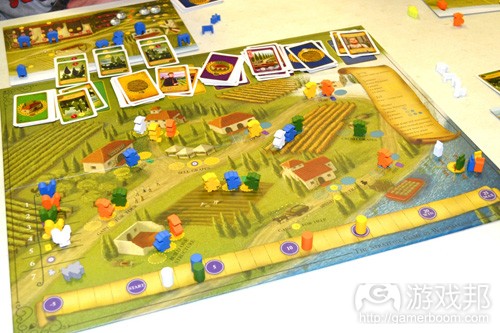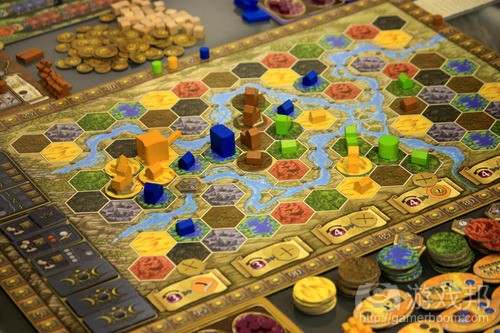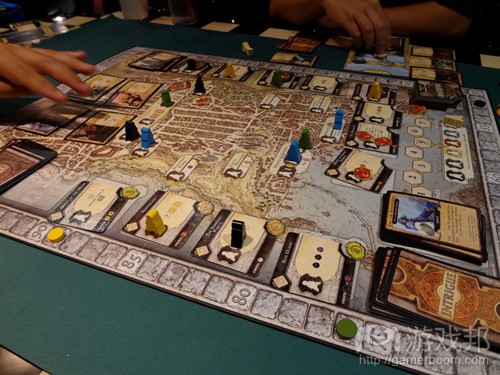桌游开发者分享2013年总结的设计经验
我在七、八岁时就开始设计游戏了。我在2004年开始发现欧式游戏,它们将我带进全新的游戏设计领域。从那时开始,我从头至尾设计了两款游戏(游戏邦注:它们分别是《Viticulture》和《Euphoria》),在最近几年我玩了大量游戏。
尽管如此,我在2013年所学到的游戏设计知识远甚于过去几年的总和。这并不是说我就是个优秀的设计师,而是说我现在比过去更了解游戏设计。因此我想在此分享我今天所学到的游戏设计经验。
1.一切都必须有趣。
这并不是老生常谈。而是游戏设计最重要的原则:游戏的每个层面都应该最大化趣味性。在制定游戏的每个决定之前,要先自问“这会有趣吗?”每个机制,每个卡牌,每个骰子都应能够令游戏更有趣。这是我设计《Euphoria》时悟出的真理。该游戏中的摇骰子一度沦为人们漠不关心的行为。我由此意识到:“等一分钟。摇骰子应该具有趣味。为何这样不好玩呢?如何让它更好玩呢?”于是我就想出了双次摇骰,双个回合的方法。当然,这意味着我得想办法缓和其中的运气元素,但该想法却十分应景。摇骰子的动作令人兴奋而有趣——这并不只是因为玩家摇骰子,还因为其他玩家也会关注这一动作。在未来的游戏中,我仍会继续自问关于趣味性的问题。毕竟,这正是我们玩游戏的原因,是吗?
2.一开始的前进势头是关键。
《Terra Mystica》是前进势头和积极反馈方面的典型。它让你一直觉得自己在朝某个目标迈进,一直在进步,即便你才刚刚开始而已。而《Viticulture》却与之相反,虽然你一直在朝某方向迈进,但却甚少看到玩家赢得2个以上的胜利点数。这会令人受挫。玩家需要一些时间来积累点数。虽然这样游戏仍然具有可行性,但你最好要让玩家对自己所做的事情感觉良好,即使游戏才刚开始。在一开始就要给予他们获得点数的出路和前进势头。
3.停工期是杀手,要以粘性来解决这一问题。
很显然,停工期对游戏来说并不是好事。我早就知道这一点,并寻思着在我自己的游戏中将其划分为微决定的回合。这是一个良好的开端。但问题是,如果玩家并没有提先想好自己的微回合行动,那么就会令人觉得游戏在拖垮桌上其他玩家的行动。你无法回避这一点,但却有另一个方法:确保即使没有轮到自己的玩家也能融入其中。给予他们一个关注每个回合的理由,这样他们就不会觉得还没有轮到自己,事不关己的样子。
这方面的典型是《卡坦岛》。无论游戏中轮到谁出招,你都会关注骰子的情况,并有可能融入贸易中。这个方法很管用。
4.编写规则是一门艺术。
这里有些注意要点:首先,要关注那些难以解释的规则,然后更改机制以便令其易于解释。如果设计师难以向某人当面说明一个规则,那就可以想象1000名用户向自己的好友说明游戏规则时有多困难了。其次,要排除一切异常情况。规则的异常情况会压垮玩家,并且通常容易被忽视或遗忘。第三,有效的规则手册不仅要能够解释游戏,还要有助于玩家在游戏过程中引用特定规则。在编写规则时要将这些要点铭记在心,并考虑纳入一页的快速引用指南。第四,即使是在规则的最早期阶段,采用举例和插图的形式也会大有帮助。
5.盲测为王。
盲测是指当陌生人从规则中学习玩法并在设计师不在场的情况下试玩游戏。你可以从那些并不关心你感受的陌生人的反馈中获得许多重要信息,记住你不要在现场进行解释——这是找到游戏规则漏洞的唯一方法。
如果你很难找到盲测志愿者,不妨登陆boardgamegeek.com、bgdf.org以及meetup.org求助,从中找到愿意为他人测试游戏的志愿者。
6.创造机制与主题间的联系。
你可以上BGG去看看关于这一话题的大量争议和论坛。我的观点的是:如果主题契合机制,游戏就会易于学习和记忆。因此你的机制与主题联系越紧密,效果越好。
7.保持平衡性。
纸牌是游戏中创造可变化性的一个绝佳方法。但是,如果有些纸牌比其他纸牌更好,或者在同款游戏的不同情况下根本就没有用处,那么玩家就会觉得自己抽牌的多数时候运气都很差。关键是要一直让玩家在抽牌的时候觉得自己很幸运。
8.短期目标的价值。
我第一次玩《深水城领主》时,我觉得它是我有史以来遇到的最无趣的游戏之一。游戏就是设置一个工人,获取一些立方体,最后用这些立方体获得点数。太无聊了。但之后我用iPad玩游戏时,突然发现它是一款很棒的游戏,这些核心机制正是游戏如此出色的原因。在第一回合时,你有一些特殊的任务,以及执行这些任务的可行方法。你不需要设置一些复杂的机制令其可行。它们就在你够得着的范围内。这一点太重要了。在玩家研发自己的战略时,给予他们需要关注的短期目标,这样有利于新玩家快速融入游戏;而对于资深玩家,则要在他们的另一半大脑正在构思伟大的计划时给予他们一些需要完成的具体任务。
9.第一次游戏很重要。
这是我至今仍然受用的经验。我曾认为任何玩家第一次玩游戏时,都会很笨拙并花上很长时间。第一款游戏的作用真的很重要。它会影响玩家对该游戏的体验。就好像在读一本书的第一章时——如果它根本没有什么意义,并且很拖拉,你可能就不会去接着看第二章,即使第二章可能很精彩。所以设计自己的游戏时一定要记住这一点。这可能意味着你需要为第一款游戏提供一些说明以便玩家适应,或者你要简化整款游戏,在之后的扩展内容中 再引进复杂度。无论你采用哪种方法,我都严重建议你在整个游戏设计过程中牢记这一点。
10.尽管最小化玩家的受挫感。
这看起来是显而易见的道理——你当然也不希望玩家受挫。你也不会设计故意令玩家抓狂的游戏。但你在与其他玩家测试游戏时,却很容易忽略这些受挫感。例如,在《Viticulture》中,游戏有很大部分的局限性在于,如果其他玩家选择了一个操作,你就不能再选择这种操作。这没有关系 ,对于真正喜欢谜题体验的玩家来说,他们不会介意自己受阻。但这款游戏的问题在于,对于制作葡萄酒的过程来说,玩家行动的顺序真的很重要,所以数次受阻可能会破坏玩家的计划。所以我就添加了一名工人来解决这个问题。
11.玩多种不同类型的游戏。
我喜欢大型、复杂而迷人的游戏。所以有时候我就很难去制作轻型的游戏。但我从这些游戏中学到了许多知识,并且这有助于让我打破常规,摆脱固有的观念。(本文为游戏邦/gamerboom.com编译,拒绝任何不保留版权的转载,如需转载请联系:游戏邦)
The Top 10 Things I Learned About Game Design in 2013
I’ve been designing board games since I was 7 or 8 years old. I discovered Euro-style games in 2004, which opened me up to a whole new world of game design. Since then I’ve designed two games from start to finish (Viticulture and Euphoria), and I’ve also played a ton of games, especially in the last few years.
Despite that history, I’ve learned more about game design in 2013 than all other years combined. This is not to say I’m a good designer, but rather that I’m more aware of game design than in the past. Thus I’d like to share with you the top 10 things I’ve learned about game design this year. I’d love to hear your thoughts in the comments.
10a. Play lots of different types of games. I get excited about big, complicated, meaty games. So sometimes it’s tough for me to get lighter games to the table. But I’ve learned SO much from those games that make me think outside of the box that I often keep myself in.
My niece, the grande worker.
My niece, the grande worker.
10. Minimize frustration as often as possible. This might seem obvious–of course you don’t want players to feel frustrated. You’ll never design something to purposely frustrate players. But it’s all too easy to overlook frustration when you’re testing the game with other players. For example, in Viticulture (and many worker placement games), a big part of the game is the constraint that if other players choose an action, you may not be able to take that action. That’s fine, and for a player who really enjoys a puzzly experience, they won’t mind being blocked. But the problem in Viticulture is that order of operations really matters for the winemaking process, so getting blocked a few times can ruin your plans. So we fixed it with grande worker.
9. The first game matters. This is a lesson I’m still learning. I used to think that the first time any player plays any game, it’s going to be clunky and long. The thing is, the first game matters. It impacts a player’s experience with that game. It’s like reading the first chapter of a book–if it makes no sense and drags on forever, you may not finish it or even read chapter 2, even if chapter 2 is awesome. So keep this in mind for your games. This might mean that you include instructions for a “light” version for the first game to help players acclimate, or you might simplify the entire game and leave complexity for expansions. Regardless of how you approach it, I’d highly recommend keeping it in mind throughout the game design process.
8. The value of short-term goals. The first time I played Lords of Waterdeep, I thought it was one of the most boring games I’ve ever played. Place a worker, acquire some cubes, then eventually pay those cubes to get points. Bo-ring. But then I got it on my iPad, and I’ve come to realize that it’s a great game, and those core mechanics are exactly why the game works. From turn one, you have something specific to do (the quests) and an attainable way to do them. You don’t have to set up some complex machine to make them possible. They’re right within your reach. This is SO important. Giving players short-term goals to focus on while they develop their strategy is good for getting new gamers into a game and for giving experienced gamers concrete tasks to complete while the other half of their brains are working on their master plans.
Not balanced.
Not balanced.
7. Balance your cards. Cards are a great way to create controlled variability in a game. However, if some are simply better than others or are useless at different times in the games, players will feel unlucky the majority of the time when they draw cards. The key is to always make a player feel lucky when they draw a card.
6. Create a connection between mechanics and theme. You can go on BGG to read extensive debates and long forums on this topic for pretty much every game. Here’s the point I want to make: If the theme matches the mechanics, the game will be easier to learn and easier to remember. Thus the more you can connect the mechanics to the theme, the better.
5. Blind playtesting is king. Blind playtesting is when strangers learn a game from written rules and play it in the absence of the designer. DO IT. You will learn so much from people who don’t care about your feelings (strangers) and don’t have you there to explain the game–this is really the only way to find holes in your rules. If you struggle to find blind playtesters, look on boardgamegeek.com, bgdf.org, and meetup.org for playtest groups, and volunteer to playtest games for other people more than you ask other people to playtest for you.
4. Writing rules is an art form. A few points here: First, pay attention to rules that are difficult to explain, and then change the mechanics so they’re easier to explain. If it’s hard for you (the designer) to explain a rule to someone in person, imagine how hard it’s going to be for 1,000 customers to explain that rule to their friends on game night. Second, get rid of all exceptions. Exceptions to rules–no matter how thematic they are–will overwhelm players and often be overlooked or forgotten. Third, the key to an effective rulebook is not just to be able to explain the game, but also to help players reference specific rules while they’re playing the game. Keep both of those in mind when writing the rules and consider including a one-page quick guide for reference. Fourth, examples and illustrations go a long way, even in the earliest stages of the rules.
3. Downtime is a killer, and the solution is engagement when it’s not your turn. Obviously downtime is bad for games. I’ve known this for a while, and I’ve counteracted it by breaking down turns in my games to micro-decisions. That’s a good start. The problem is that if a player doesn’t think about their micro-turn in advance, it makes the game feel like it’s dragging on for every other player at the table. You can’t prevent it, but there is a way around it: Make sure players are engaged even when it’s not their turn. Give them a reason to pay attention on every turn and they’ll never feel like it’s not their turn. A great example is the gateway game Setters of Catan. No matter whose turn it is, you pay attention to that die roll and maybe are engaged in trading. It works.
final 32. Forward momentum from the first turn is key. Terra Mystica is the king of forward momentum and positive feedback. You always feel like you’re building towards something, always advancing, even from your first turn. Contrast that with Viticulture. You’re always building towards something, but it’s not uncommon to look at a Viticulture scoring track 4 turns into the game and see no player with more than 2 victory points. That can be discouraging. It simply takes a while for players to accumulate points. The game still works, but you want players to feel good about what they’re doing, even early in the game. Give them outlets for points and forward momentum from the first turn.
black and white1. Everything must be FUN. I don’t mean this in the generic sense. This isn’t a cliche. This is the number one most important thing about game design: every aspect of the game should maximize fun. “Is this fun?” Ask yourself that for every decision you make about the game. Every mechanic, every card, every roll of the die should make the game more fun. This is something I really learned during the design for Euphoria. At one point the game evolved to the point that rolling dice became a nonchalant gesture that no one paid attention to. They might as well not have been dice. I realized: “Wait a minute. Dice rolling should be fun. How is this not fun? How can it be more fun?” That’s when I came up with the idea of rolling doubles leading to double turns. Sure, it meant I had to find ways to mitigate the luck factor involved, but right away the idea clicked. The act of rolling dice was exciting and fun–not just for the player rolling, but other players paid attention as well. I’ll continue to ask myself the fun question for future games, and I hope you do too. That’s why we play games, right?(source:stonemaiergames)
上一篇:游戏也能够创造出伟大的艺术品










































 闽公网安备35020302001549号
闽公网安备35020302001549号